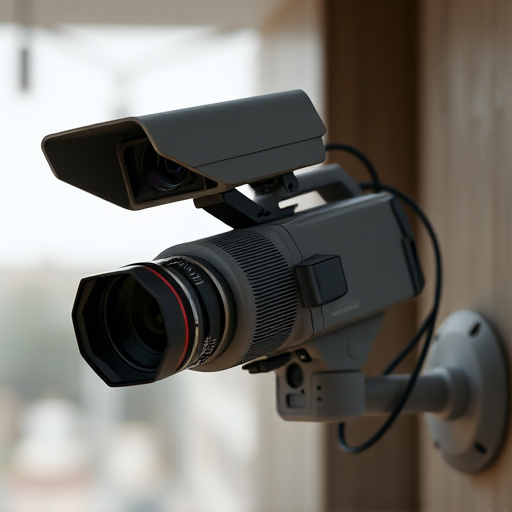Dummy security cameras with blinking lights are an effective crime deterrent when strategically placed, but their effectiveness hinges on realistic positioning and integration into a broader security strategy. There are two types—PIR for indoor and high-resolution CCTV for outdoor use. Proper placement combines deception (dummy cameras) and reality (discreet real cameras) to enhance deterrence. Legal considerations regarding surveillance laws and privacy regulations must be understood before installation, especially concerning moving parts and blinking lights which may face legal scrutiny. Blinking lights maximize deterrent effect by simulating active camera monitoring, placed at key areas like entrances with realistic hardware for optimal crime prevention.
“Enhance your home or business security without breaking the bank with dummy camera placement strategies. This guide explores the benefits and misconceptions surrounding fake security cameras, also known as dummy cameras with blinking lights. Learn how these devices can deter crime effectively and where to strategically place them for optimal deterrent effect. We’ll also cover legal considerations and advanced techniques to maximize their effectiveness.”
- Understanding Dummy Camera Placement: Benefits and Misconceptions
- Types of Blinking Light Cameras and Their Uses
- Strategic Positioning for Optimal Deterrence
- Legal Considerations: When and Where to Install Fake Security Cameras
- Advanced Techniques to Enhance the Effectiveness of Dummy Cameras
Understanding Dummy Camera Placement: Benefits and Misconceptions
Dummy security cameras, often recognized by their blinking lights, have become a prevalent deterrent in home and business security systems. Their placement strategy involves positioning them at strategic locations to create the illusion of constant surveillance. This approach offers several benefits; potential intruders are deterred by the visible presence of these cameras, encouraging them to choose easier targets. In fact, research shows that dummy cameras can reduce crime rates significantly, especially when paired with genuine security systems.
However, there are misconceptions surrounding their effectiveness. Many believe that these cameras provide comprehensive protection, but they serve as a psychological barrier rather than an active surveillance tool. Proper placement is crucial; random or obvious positioning may even invite pranksters. For optimal results, dummy cameras should be integrated into the overall security strategy, mimicking real camera locations to maintain an authentic deterrent effect.
Types of Blinking Light Cameras and Their Uses
Dummy cameras with blinking lights come in various types, each suited for specific security needs. Passive infrared (PIR) cameras are common, using heat detection to trigger lights and motion sensors. These are ideal for indoor spaces, as they can capture clear images during night-time or low-light conditions without being easily noticeable.
Another type is the color CCTV camera with blinking lights, offering higher resolution and day/night vision capabilities. These cameras are suitable for outdoor applications, providing detailed footage even in different lighting environments. Their blinking lights act as a deterrent, signaling potential intruders that they’re under surveillance.
Strategic Positioning for Optimal Deterrence
Strategic placement of security cameras, including dummy cameras with blinking lights, can significantly enhance deterrence and overall security. These devices serve as powerful visual cues, sending a clear message to potential intruders that they are being watched. By positioning them at key entry points, such as main doors, windows, and areas with valuable assets, you create a psychological barrier that discourages unauthorized access.
The optimal strategy involves a combination of visible and hidden cameras. Visibly placed dummy cameras with their distinctive blinking lights act as decoys, drawing attention and making would-be criminals more cautious. Simultaneously, discreetly installed real cameras provide constant surveillance, capturing clear footage for evidence in case of an actual intrusion. This blend of deception and reality creates a robust security network that significantly reduces the risk of crime.
Legal Considerations: When and Where to Install Fake Security Cameras
When considering the strategic placement of dummy security cameras with blinking lights, it’s crucial to understand legal boundaries and regulations. In many jurisdictions, there are strict rules regarding surveillance and privacy rights, especially in public spaces and commercial areas. Before installing any fake cameras, property owners or managers should familiarize themselves with local laws and obtain necessary permits to ensure compliance. This includes understanding the distance restrictions from public view, the types of areas that require consent for monitoring (like parking lots or common areas), and data retention policies.
The legality of dummy cameras also varies based on their appearance and functionality. While static fake cameras are generally less controversial, those with moving parts or blinking lights might be perceived as more realistic and thus, attract legal scrutiny. It’s essential to consult with a legal expert to navigate these complexities and understand the potential consequences of using security measures that could be misconstrued as active surveillance. This guarantees you maintain a safe environment while avoiding any unintended legal repercussions.
Advanced Techniques to Enhance the Effectiveness of Dummy Cameras
To maximize the effectiveness of dummy security cameras, consider advanced techniques like incorporating blinking lights. This simple yet powerful feature simulates real camera activity, making potential intruders less likely to attempt unauthorized entry. By programming the lights to blink at irregular intervals, you create a dynamic and unpredictable environment, enhancing the deterrent effect.
Additionally, strategic placement is key. Mount dummy cameras in areas that offer clear views of essential points, such as entrances, exits, and common gathering spots. The mere presence of these cameras can deter criminal activity, even if they are not recording. For added realism, pair them with realistic-looking cables and mounting hardware, further convincing would-be criminals that your property is under constant surveillance.
In conclusion, dummy cameras with blinking lights offer a cost-effective and strategic way to enhance security while deterring potential criminals. By understanding their benefits, exploring different types, and strategically placing them, you can create an effective surveillance network. However, always consider legal guidelines to ensure proper installation, as these devices should be used responsibly to maintain public trust. With advanced techniques and clever positioning, dummy cameras can serve as a powerful tool in your security arsenal.
